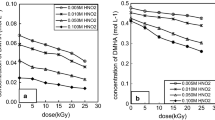Abstract
This paper reports the study of hydrogen and carbon monoxide produced by radiation degradation of N, N-dimethylhydroxylamine (DMHA). The results show that when the concentration of DMHA is between 0.1M–0.5M and the dose is between 10–1000 kGy, the volume fraction of hydrogen is very high and increases with the dose. The volume fraction of hydrogen is little dependent on the concentration of DMHA at lower dose but increases with increasing concentration of DMHA at higher dose. The volume fraction of carbon monoxide is very low.
Similar content being viewed by others
References
Sh. J. Jiang, F. Y. Ren, Engineering Science of Reprocessing of Nuclear Fuel, Atomic Energy Publisher, Beijing, 1995, p. 93 (in Chinese).
C. S. Schlea, M. R. Caverly, H. E. Henry, W. J. Jenkins, Uranium(IV) Nitrate as a Reducing Agent for Plutonium(IV) in the PUREX Process, DP-808, 1963, p. 1.
P. Biddle, J. H. Miles, J. Inorg. Nucl. Chem., 30 (1968) 1291.
W. Ochsenfeld, G. Petrich, Separ. Sci. Technol., 18 (1983) 1685.
V. S. Koltunov, S. M. Baranov, T. P. Zharova, Radiokhimiya, 35 (1993) 49 (in Russian).
A. Y. Zhang, K. Li, H. He, J. X. Hu, X. Y. Zhang, F. D. Wang, Chinese J. Appl. Chem., 18 (2001) 180 (in Chinese).
V. S. Koltunov, Stabilization of Pu and Np Valences in Purex process, Problems and Outlook, RECOD’98, p. 425.
P. Zhang, R. X. Xin, J. F. Liang, Modern Machine, 5 (2000) 10 (in Chinese).
W. J. Havenga, E. R. Rohwer, J. High Resolut. Chromatogr., 15 (1992) 381.
Y. J. Qian, H. Y. Cheng, W. J. Fang, At. Energy Sci. Technol., 7 (1964) 868.
J. H. Wang, B. R. Bao, M. H. Wu, X. L. Sun, X. Y. Zhang, J. X. Hu, G. A. Ye, Nucl. Technol., 27 (2004) 301 (in Chinese).
J. H. Wang, B. R. Bao, M. H. Wu, X. L. Sun, X. Y. Zhang, J. X. Hu, G. A. Ye, J. Nucl. Radiochem., 26 (2004) 103 (in Chinese).
J. L. Wu, Sh.Ch. Qi, Radiation Chemistry, Atomic Energy Publisher, Beijing, 1993, p. 156 (in Chinese).
J. W. T. Spinks, R. J. Woods, An Introduction to Radiation Chemistry, 2nd. ed. Wiley-Interscience, New York, 1976, p. 247.
Author information
Authors and Affiliations
Rights and permissions
About this article
Cite this article
Wang, J.H., Wu, M.H., Bao, B.R. et al. Study on hydrogen and carbon monoxide produced by radiation degradation of N,N-dimethylhydroxylamine. J Radioanal Nucl Chem 273, 371–373 (2007). https://doi.org/10.1007/s10967-007-6842-7
Received:
Published:
Issue Date:
DOI: https://doi.org/10.1007/s10967-007-6842-7




